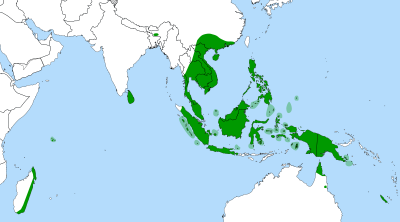The Nepenthaceae, and in particular the only genus in this family, the genus Nepenthes, has been described in a previous blog, posted on this site by Garance (Wood-Moulin 2013). In that blog the morphology and development of pitcher plants has been illustrated together with an account on the overall taxonomy of the genus Nepenthes.
For additional information and illustrations on the Nepenthaceae, the reader should refer to “Flowering Plant Families of The World (Heywood et al. 2007).
In this account I will be focusing on a species described in 1998, Nepenthes mira. The botanical description for this new species was first given by Matthew Jebb and Martin Cheek in 1998 (Cheek et al. 1998). A full description and illustration of the “Wonderful” pitcher plant (from the Latin mirus meaning wonderful) was published in 1999 (Cheek et al. 1999).
Distribution
The overall distribution of the genus Nepenthes is shown in the adjacent map. Nepenthes mira is endemic to, Palawan the largest island of the Palawan Province in the Philippines. This beautiful island is fast becoming a major tourist destination. A quick web search on the island will show how the natural beauty and untouched landscape of the Palawan Island is a “must go to see” destination for tourists escaping from more traditional tourist sites (Palawan Island Images). To protect this new species from the ever increasing number of people visiting the island, “The exact collection localities have been withheld in view of the threat from plant collectors to rare and new species of this genus” (Cheek et al. 1999).
Protection Status
In the IUCN Red List of Threatened Species, Nepenthes mira is classified as Vulnerable. It has been estimated that there are only 600 mature plants of this species in Mount Cleopatra. So why is it not given a higher level classification such as Endangered? The main reason is that “Mt. Cleopatra, its remote location, coupled with a lack of threats from habitat destruction or over-collection of wild plants” (IUCN Red List 2014) does not justify giving it anything more than the status of Vulnerable. At least for the present. Consequently, “N. mira is not the subject of any species-specific conservation programmes at present.” (IUCN Red List 2014).
Distinguishing features
We are fortunate enough to have a specimen of Nepenthes mira in our tropical greenhouse. See below. The description given by Martin Cheek and Matthew Jebb (Cheek et al 1999) is extremely detailed and meant to be the source to be used on specimens to confirm if they are indeed Nepenthes mira. I thought it would be interesting to look at a few characters of our own plant to see how they match. The following annotated photographs illustrate some of the main features visible in our specimen:

The presence of two fringed wings, with unpaired elements, going all the way down to near the base of the pitcher is more a distinctive feature of N. philippinensis (Cheek et al 1999, p.888-889), not of N. mira. Do we have some form of hybrid, or could it be that looking at only one specimen is insufficient to draw a definite conclusion? Our specimen only has basal pitchers. Examination of the upper pitchers would be of great value. However our specimen is young. Time is needed for our specimen to grow further and develop upper pitchers. Detail examination of flowers, once they develop, will further assist in confirming if this specimen is N. mira. The actual status of this species is, furthermore still unclear. In The Plant List it is listed as “Unresolved” (The Plant List). Further observational work will be carried out during the year with the hope of getting closer to confirming the species status of our plant.
REFERENCES
Cheek, M.R. & M.H.P. Jebb (1998). Two new Philippine Nepenthes. Kew Bulletin 53(4): 966. doi:10.2307/4118886
Cheek, Martin; Jebb, Matthew (1999). Nepenthes (Nepenthaceae) in Palawan, Philippines. Kew Bulletin 54(4): 887-895. DOI: 10.2307/4111166
Wood-Moulin, Garance (2013) A Look at the Carnivorous World, Nepenthaceae
Heywood,V.H., Brummitt,R.K., Culham.A., Seberg,O. (2007) Flowering Plant Families of The World. London: The Brown Reference Group PLC.
The Red List http://www.iucnredlist.org/details/48993996/0
The Plant List http://www.theplantlist.org/tpl1.1/record/kew-2383461















